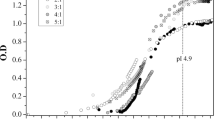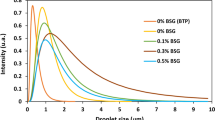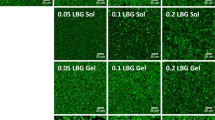Abstract
In this study, whey protein concentrate (WPC) and xanthan gum (XG) hydrogels were developed with cooperation of basil seed nanoparticles (BSG NPs) (1 and 3%), two different levels of salt (150 and 300-mM CaCl2), and acidic pH (3.5). The five types of hydrogels were synthesized and characterized mechanically and morphologically using different methods such as SEM, swelling ratio, DSC, WHC, and texture analysis. The results showed that the hardness and consistency of the hydrogel system reached the most at the WPC–XG (300-mM CaCl2) among the samples. The hardness was 931.83 g, and the consistency was 28297.8 g s. For WHC analysis, WPC–XG (150-mM CaCl2) sample got the highest rate of the WHC (%) at 95.39%. The highest rate of swelling ratio was attributed to WPC–XG (BSG NPs 3%) composite. From DSC analysis, the highest peak temperature (Tp) at 114 °C relates to WPC–XG (BSG 3%), the highest onset temperature (To) at 99 °C, relates to WPC–XG (BSG 1%), and the sample containing WPC–XG (150-mM CaCl2). The highest value of enthalpy of gelatinization (ΔH) belongs to WPC–XG (BSG NPs 3%) samples.

Highlights
-
WPC-XG hydrogel was modified with cooperating of nanoparticles, CaCl2, and acidic pH.
-
The highest rate of swelling ratio was attributed to WPC-XG (BSG NPs 3%) composite.
-
DSC revealed BSG NPs 3% promoted heat stability of the hydrogel.
-
300 mM CaCl2 improved the hardness and consistency of the hydrogel system.
-
WPC hydrogels become more porous by adding BGS NPs.




Similar content being viewed by others
References
Sabbagh F et al. (2020) Green synthesis of Mg0. 99 Zn0. 01O nanoparticles for the fabrication of κ-Carrageenan/NaCMC hydrogel in order to deliver catechin. Polymers 12(4):861
Zhang H, Zhang F, Yuan R (2020) Applications of natural polymer-based hydrogels in the food industry. In: Hydrogels based on natural polymers. Elsevier, p 357–410
Sabbagh F et al. (2018) From formulation of acrylamide-based hydrogels to their optimization for drug release using response surface methodology. Mater Sci Eng: C 92:20–25
Naji S, Razavi SMA (2014) Functional and textural characteristics of cress seed (Lepidium sativum) gum and Xanthan gum: effect of refrigeration condition. Food Bioscience 5:1–8
Naji S, Razavi S, Karazhiyan H (2012) Effect of thermal treatments on functional properties of cress seed (Lepidium sativum) and xanthan gums: a comparative study. Food Hydrocoll 28(1):75–81
Naji S, Razavi SM, Karazhiyan H (2013) Effect of freezing on functional and textural attributes of Cress seed gum and Xanthan gum. Food Bioprocess Technol 6(5):1302–1311
Sworn G (2000) Xanthan gum in handbook of hydrocolloids. In: Phillips GO, Williams PA (eds) Woodhead Publishing Limited, Cambridge, UK
Setiowati AD et al. (2017) Improved heat stability of whey protein isolate stabilized emulsions via dry heat treatment of WPI and low methoxyl pectin: effect of pectin concentration, pH, and ionic strength. Food Hydrocoll 63:716–726
Qi PX, **ao Y, Wickham ED (2017) Changes in physical, chemical and functional properties of whey protein isolate (WPI) and sugar beet pectin (SBP) conjugates formed by controlled dry-heating. Food Hydrocoll 69:86–96
Behrouzain F, Razavi SM, Joyner H (2020) Mechanisms of whey protein isolate interaction with basil seed gum: influence of pH and protein-polysaccharide ratio. Carbohydr Polym 232:115775
Dannert C, Stokke BT, Dias RS (2019) Nanoparticle-hydrogel composites: from molecular interactions to macroscopic behavior. Polymers 11(2):275
Hiltunen R, Holm Y (1999) Basil: the genus Ocimum. Harwood Academic Publishers, Netherlands
Naji-Tabasi S, Razavi SMA (2017) Functional properties and applications of basil seed gum: an overview. Food Hydrocoll 73:313–325
Zeynali M, Naji-Tabasi S, Farahmandfar R (2019) Investigation of basil (Ocimum bacilicum L.) seed gum properties as cryoprotectant for frozen foods. Food Hydrocoll 90:305–312
Naji Tabasi S et al. (2020) Investigation of oleogel properties prepared by pickering emulsion-templated stabilized with solid particles of basil seed gum and isolated soy protein as a fat substitute in cream. Res Innov Food Sci Technol 9(3):267–280
Naji-Tabasi S et al. Nanoparticles fabrication of soy protein isolate and basil seed gum (Ocimum bacilicum L.) complex as pickering stabilizers in emulsions. J Dispers Sci Technol 2019:1–8
Ye A (2008) Complexation between milk proteins and polysaccharides via electrostatic interaction: principles and applications—a review. Int J food Sci Technol 43(3):406–415
Cui X et al. (2018) Effects of mixing ratio and pH on the electrostatic interactions of hydrolyzed Alaska Pollock protein and κ‐Carrageenan. J food Sci 83(8):2176–2182
Demetriades K, Coupland JN, McClements D (1997) Physical properties of whey protein stabilized emulsions as related to pH and NaCl. J Food Sci 62(2):342–347
Sun C, Gunasekaran S, Richards MP (2007) Effect of xanthan gum on physicochemical properties of whey protein isolate stabilized oil-in-water emulsions. Food Hydrocoll 21(4):555–564
Bertrand M-E, Turgeon SL (2007) Improved gelling properties of whey protein isolate by addition of xanthan gum. Food Hydrocoll 21(2):159–166
Perez AA et al. (2010) Milk whey proteins and xanthan gum interactions in solution and at the air–water interface: a rheokinetic study. Colloids Surf B: Biointerfaces 81(1):50–57
Naji-Tabasi S, Razavi SMA, Mehditabar H (2017) Fabrication of basil seed gum nanoparticles as a novel oral delivery system of glutathione. Carbohydr Polym 157:1703–1713
Liu F et al. (2018) Ethanol-induced composite hydrogel based on propylene glycol alginate and zein: formation, characterization and application. Food Chem 255:390–398
Naeem F et al. (2017) pH responsive cross-linked polymeric matrices based on natural polymers: effect of process variables on swelling characterization and drug delivery properties. BioImpacts 7(3):177
Matia-Merino L et al. (2019) The impact of basil seed gum on native and pregelatinized corn flour and starch gel properties. Food Hydrocoll 89:122–130
Sugino A, Miyazaki T, Ohtsuki C (2008) Apatite-forming ability of polyglutamic acid hydrogels in a body-simulating environment. J Mater Sci: Mater Med 19(6):2269–2274
Pelegrine D, Gasparetto C (2005) Whey proteins solubility as function of temperature and pH. LWT-Food Sci Technol 38(1):77–80
Razi SM et al. (2018) The effect of basil seed gum (BSG) on the rheological and physicochemical properties of heat-induced egg albumin gels. Food Hydrocoll 82:268–277
**e L et al. (2012) Controlled mechanical and swelling properties of poly (vinyl alcohol)/sodium alginate blend hydrogels prepared by freeze–thaw followed by Ca2+ crosslinking. J Appl Polym Sci 124(1):823–831
Naji-Tabasi S et al. (2016) New studies on basil (Ocimum bacilicum L.) seed gum: part I—fractionation, physicochemical and surface activity characterization. Food Hydrocoll 52:350–358
Thessrimuang N, Prachayawarakorn J (2019) Development, modification and characterization of new biodegradable film from basil seed (Ocimum basilicum L.) mucilage. J Sci Food Agric 99(12):5508–5515
Ibrahim SM, Abou El Fadl FI, El-Naggar AA (2014) Preparation and characterization of crosslinked alginate–CMC beads for controlled release of nitrate salt. J Radioanalytical Nucl Chem 299(3):1531–1537
Lin Y-H et al. (2005) Physically crosslinked alginate/N, O-carboxymethyl chitosan hydrogels with calcium for oral delivery of protein drugs. Biomaterials 26(14):2105–2113
Tavakol M et al. (2009) Sulfasalazine release from alginate-N, O-carboxymethyl chitosan gel beads coated by chitosan. Carbohydr Polym 77(2):326–330
Tavakol M, Vasheghani-Farahani E, Hashemi-Najafabadi S (2013) The effect of polymer and CaCl 2 concentrations on the sulfasalazine release from alginate-N, O-carboxymethyl chitosan beads. Prog Biomater 2(1):1–8
Facin BR et al. (2015) Immobilization and controlled release of β-galactosidase from chitosan-grafted hydrogels. Food Chem 179:44–51
Author information
Authors and Affiliations
Corresponding author
Ethics declarations
Conflict of interest
The authors declare no competing interests.
Additional information
Publisher’s note Springer Nature remains neutral with regard to jurisdictional claims in published maps and institutional affiliations.
Rights and permissions
About this article
Cite this article
Pilevaran, M., Tavakolipour, H., Naji-Tabasi, S. et al. Development of mechanical and thermal properties of whey protein–xanthan gum hydrogel by incorporation of basil seed gum nanoparticles, salt, and acidic pH. J Sol-Gel Sci Technol 98, 76–83 (2021). https://doi.org/10.1007/s10971-021-05508-y
Received:
Accepted:
Published:
Issue Date:
DOI: https://doi.org/10.1007/s10971-021-05508-y




